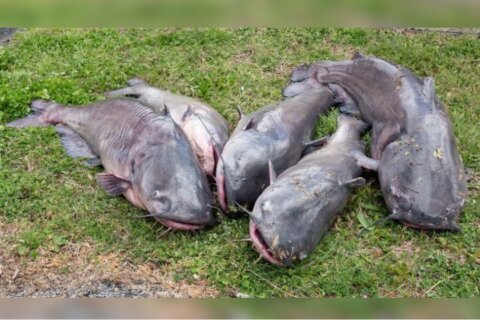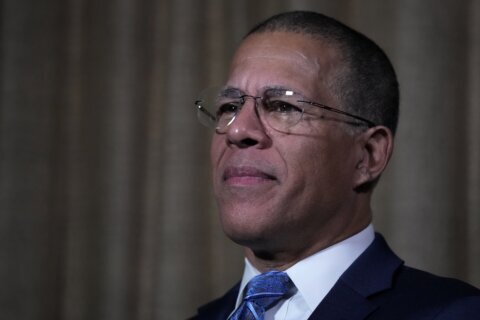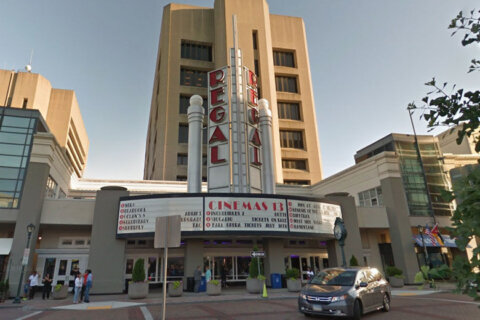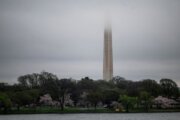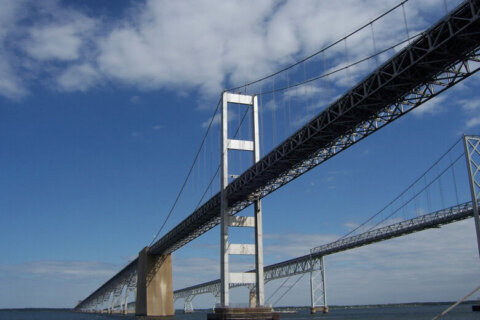
(CNN) — Before its disastrous collapse last week, the Francis Scott Key Bridge served as an economically crucial gateway: thousands of container ships crossing from the Atlantic to Baltimore’s port passed under the bridge’s decades-old span.
But the now-ruined structure isn’t the only bridge along that same key shipping route: Twenty miles downstream, massive container ships headed to Baltimore also pass under the Chesapeake Bay Bridge near Annapolis. And according to experts who reviewed its design for CNN, it could also be at risk of collapse if one of those vessels rammed into it.
Several of the four-mile-long Bay Bridge’s concrete piers, which sit in the middle of the shipping channel, appear vulnerable to the type of ship collision that destroyed the Key Bridge, experts said.
The bridge is “lacking in safety measures,” said Adel ElSafty, an engineering professor at the University of North Florida, who said the structure should be reassessed in light of the Key Bridge collapse. “It could very much be vulnerable to a ship impact.”
CNN reviewed the protective design features of more than a dozen major US bridges that cross shipping channels leading to the biggest ports in the country. Most have stronger defenses against ship collisions than the Key Bridge had, such as more robust fender systems or larger concrete structures designed to deflect oncoming vessels, according to statements from local officials and interviews with more than a half-dozen structural engineering experts.
But a handful of other bridges, including the Chesapeake Bay Bridge, have less significant defenses, according to experts – potentially placing them at risk as increasingly large container ships pass under them.
Most of the bridges, like the Key Bridge, contain “fracture critical members,” according to federal data – meaning that if a single element is taken out, the entire structure could fall. The Key Bridge collapsed after the ship knocked out one of its vertical support piers, and likely would have fallen even if it hadn’t had fracture critical members, said Matthew Yarnold, an engineering professor at Auburn University.
The Baltimore disaster – which killed six people, has indefinitely shut down America’s 15th largest port, and is projected to cost billions of dollars in damages – has illustrated the massive economic and social consequences to any of these critical infrastructure links failing.
But others are projecting confidence even if it may be unfounded. A Louisiana Department of Transportation spokesperson told CNN that a major New Orleans bridge was “triple protected” due to its design, a statement that one structural engineer called “nonsense.”
Now, officials are scrambling to evaluate the risk to other bridges and predict whether they would survive what a week ago was an almost-unthinkable event. Some agencies were already in the process of bulking up bridge defenses, with officials in Delaware and Pennsylvania spending tens of millions of dollars to install new concrete structures and rock islands protecting bridges across the shipping channel leading to the Port of Philadelphia. And the Maryland Transportation Authority said Tuesday it was considering adding increased protections to the Bay Bridge.
Experts disagree about whether any kind of protection could realistically save a bridge from a direct hit by a container ship as massive as the Dali, the vessel that took out the Key Bridge. But they say the collapse should require a renewed risk assessment and investment in defense systems that could at least reduce the possibility of such a disaster.
“I don’t think we should be sitting ducks,” said Abieyuwa Aghayere, a professor of structural engineering at Drexel University. “If you cannot design a system to stop a ship from hitting a pier, then by all means, tear down the bridge.”
How to protect a bridge
Around the US, bridge engineers have used various methods to protect bridges from ship collisions, aiming to slow or deflect oncoming vessels.
The most basic involves surrounding bridge support piers with “fenders,” structures that are attached to a bridge’s support pier and can withstand the impact of a ship. Documents and photos appear to show the Key Bridge had concrete and timber fenders before its collapse. Experts said that some materials were better than others, and questioned whether any fenders constructed of timber would do much to halt a massive container ship.
Other bridges have installed “dolphins,” circular, typically concrete structures detached from a bridge that can block ships before they reach a bridge. Major bridges near Jacksonville, Florida, and Mobile, Alabama, for example, have large dolphins between their main piers and the shipping channels they cross.
Still, dolphins don’t always work – as the Key Bridge disaster demonstrates. When the sun rose in Baltimore last week after the early-morning collapse, one of the four small dolphins around the bridge could be seen intact to the side of the Dali’s hull, amid a tangled mess of fallen steel. The ship had hit the bridge at an angle that just missed the dolphin, rendering it useless.
Several experts told CNN that the Key Bridge’s dolphins seemed to be of inadequate size. “You don’t want a ship to be able to maneuver around the dolphins and still hit the bridge directly,” Aghayere said.
Other bridges are protected by barrier islands. The Arthur Ravenel Jr. Bridge in Charleston, South Carolina, for example, has the foundations of its main support piers surrounded by artificial islands made up of stone masses that weigh up to 4,000 pounds and were shipped from Newfoundland, Canada.
The islands, which extend roughly 200 feet in every direction around the bridge supports, were designed to ensure that ships “would run aground before they ever got to the pier, the actual foundation of the bridge,” said Rob Perry, the South Carolina Department of Transportation’s interim deputy secretary for engineering. “When you have a one-billion-dollar bridge, you don’t want to lose it.”
Even if structural defenses don’t completely stop an oncoming ship, they can slow or deflect it enough to lessen the blow on critical structural components of a bridge, experts said.
Strong enough protections should “give you time,” said Barzin Mobasher, an Arizona State University engineering professor. Slowing an impact by a few seconds can make a difference: The time it takes for a ship to fully stop is “critical in survivability” for a bridge, Mobasher said.
These kinds of protections have become even more important in recent years as cargo ships have grown in size, because collisions from larger, heavier ships carry more force and do more damage. Before an expansion of the Panama Canal in 2016, ships as big as the Dali didn’t typically frequent East Coast ports like Baltimore.
Several experts pointed to the reconstructed Sunshine Skyway Bridge across Tampa Bay as a standout in terms of protection. An earlier version of the bridge collapsed in 1980 after a container ship rammed into it, killing 35 people.
For the reconstructed new bridge, which opened in 1987, engineers surrounded several of the bridge’s piers with a total of 36 large dolphins and placed other piers on substantial barrier islands.
That disaster also led to changes in bridge standards. Current bridge design codes, written by an association of state transportation officials, say that bridges in “navigable waterways where vessel collision is anticipated” should be “designed to resist vessel collision forces” or “adequately protected by fenders, dolphins, berms, islands, or other sacrifice-able devices.”
Some other bridges have more natural protection – their support piers are either situated on land or in shallow water, meaning that ships that veer off course are likely to run aground before they hit the bridge.
Potential vulnerabilities
Most of the bridges reviewed by CNN that are above major container shipping channels either had larger dolphins than the Key Bridge, barrier islands around their main piers, or only had piers situated on land or in shallow water. But experts pointed to at least two major bridges where protections appear to be especially lacking.
About twenty miles downstream from the Key Bridge, the Chesapeake Bay Bridge connects residents of the Washington, DC, and Baltimore regions to beach towns on the eastern shore of Maryland and the Delaware coast. The four-mile bridge opened to traffic in 1952 and added a second span in 1973.
Some of the bridge’s support piers are encased in substantial amounts of concrete. But structural engineering experts told CNN that other piers – including some close to the main navigation channel – appear far less protected, with fenders that might not withstand major collisions. The bridge also has no dolphins, according to photos and the National Oceanic and Atmospheric Administration navigational chart for the area.
A ship as big as the Dali “would eat through this in a second,” said Hussam Mahmoud, a Colorado State University engineering professor and bridge expert. Of more than a dozen bridges over major US shipping channels, he said, the Bay Bridge appeared to be among the most vulnerable.
Mobasher, the Arizona State professor, agreed, saying that he doubted the bridge’s protections would be “sufficient to slow down a ship that is even much smaller than the Dali.”
In a statement Tuesday, the Maryland Transportation Authority, which oversees the Key and Bay bridges, said officials were reviewing protections at the Bay Bridge in light of the Key Bridge collapse. The authority is “looking at options with the U.S. Coast Guard on the feasibility of increased pier protections for the Bay Bridge and what’s possible in the navigation channel,” a spokesperson said.
The Bay Bridge is currently undergoing construction to upgrade its aging road deck and parts of its steel superstructure, but the work does not appear to involve any additional protections against ship collisions. The state has also been studying adding a third span to the bridge to alleviate chronic traffic congestion – a project that is still in preliminary stages.
Pete Lesher, the chief historian of the Chesapeake Bay Maritime Museum and a local official in Talbot County, near the Bay Bridge’s east side, said the Baltimore collapse has worried his community about the dangers of it being hit as well.
“I don’t think that anybody has really had time to turn attention to the Chesapeake Bay Bridge spans other than to say we potentially have a vulnerability here as well,” Lesher said.
Both the Key and Bay bridges have been “economically vital and beloved landmarks,” he said. “It’s certainly devastating to us in this region to see this loss – and our potential future vulnerabilities.”
In addition to the Chesapeake Bay Bridge, experts also pointed to the Crescent City Connection, a pair of cantilever bridges that span the Mississippi River near downtown New Orleans, as potentially vulnerable. The bridges opened in 1958 and 1988, and more than 250,000 vehicles cross the structures every day on average, according to federal data.
The two bridges each have support piers in the river, not far from the navigation channel heading to the Port of New Orleans. A spokesperson from the state Department of Transportation wrote in an email to CNN that the bridge is “like triple protected” because it has a “solid concrete” pier surrounded by a “concrete barrier” and a “timber fender system.”
But several structural engineers questioned that. Mahmoud, the Colorado State professor, said the idea of triple protection was “nonsense,” and argued that the fender system was “definitely inadequate” to protect against a strike by a large ship.
“Timber is not going to work,” he said. “Wood is completely irrelevant as far as this magnitude of load is considered.”
The state spokesperson noted that there are plans to build a new container terminal further downriver, which will not require ships to pass under the bridge, and said that “the fender system has worked as designed for many years based on the number and size of vessels in that location.” The size of ships may be changing, however: In 2022, the port welcomed the longest vessel to ever dock there – a ship even longer than the Dali.
Investing in defense
Not far from Baltimore, some officials are already in the middle of construction projects to beef up bridge defenses.
On the Delaware River between Delaware, New Jersey and Pennsylvania, container ships headed from the Atlantic to the Port of Philadelphia pass under four major bridges. Authorities in charge of those crossings started planning to defend against a similar disaster years ago
“We’re constantly trying to be ahead of the threats,” John Hanson, the CEO of the Delaware River Port Authority, said in an interview. “We’re not going to build something that’s obsolete the moment that we complete construction.”
Two decades ago, the authority ran a threat assessment that considered the risk of impacts from new, massive container ships, Hanson said. Between that review and more regular inspections of the four bridges that include divers and underwater sonar, officials decided to install new barrier islands around the piers of the Commodore Barry Bridge south of Philadelphia.
Meanwhile, the Delaware River and Bay Authority is in the middle of a $93 million construction project to install eight dolphins around the piers of the Delaware Memorial Bridge near Wilmington. The structures are designed to halt oncoming ships even larger than the Dali, according to the authority.
There are also plans to update the timber fender defenses of the Walt Whitman Bridge and the Benjamin Franklin Bridge in Philadelphia – both of which have support piers in shallow water – over the next few years. In addition, officials are expediting additional safety evaluations of two other bridges in the wake of the Baltimore collapse.
“We believe that the systems that we have in place right now are more than capable of handling any type of accident that we might see, but we are not complacent,” Hanson said. “The bridges are owned by the community and we hold them in trust for the community. It’s our job to turn them over to the to the next generation… in better condition than we got them.”
Other bridge authorities should be considering making similar investments in collision protections, experts argued.
“We can’t just sit on our hands and say there is nothing we can do,” said Aghayere, the Drexel professor. “I’m of the view that you have to find a solution – and there are solutions.”
The-CNN-Wire
™ & © 2024 Cable News Network, Inc., a Warner Bros. Discovery Company. All rights reserved.

